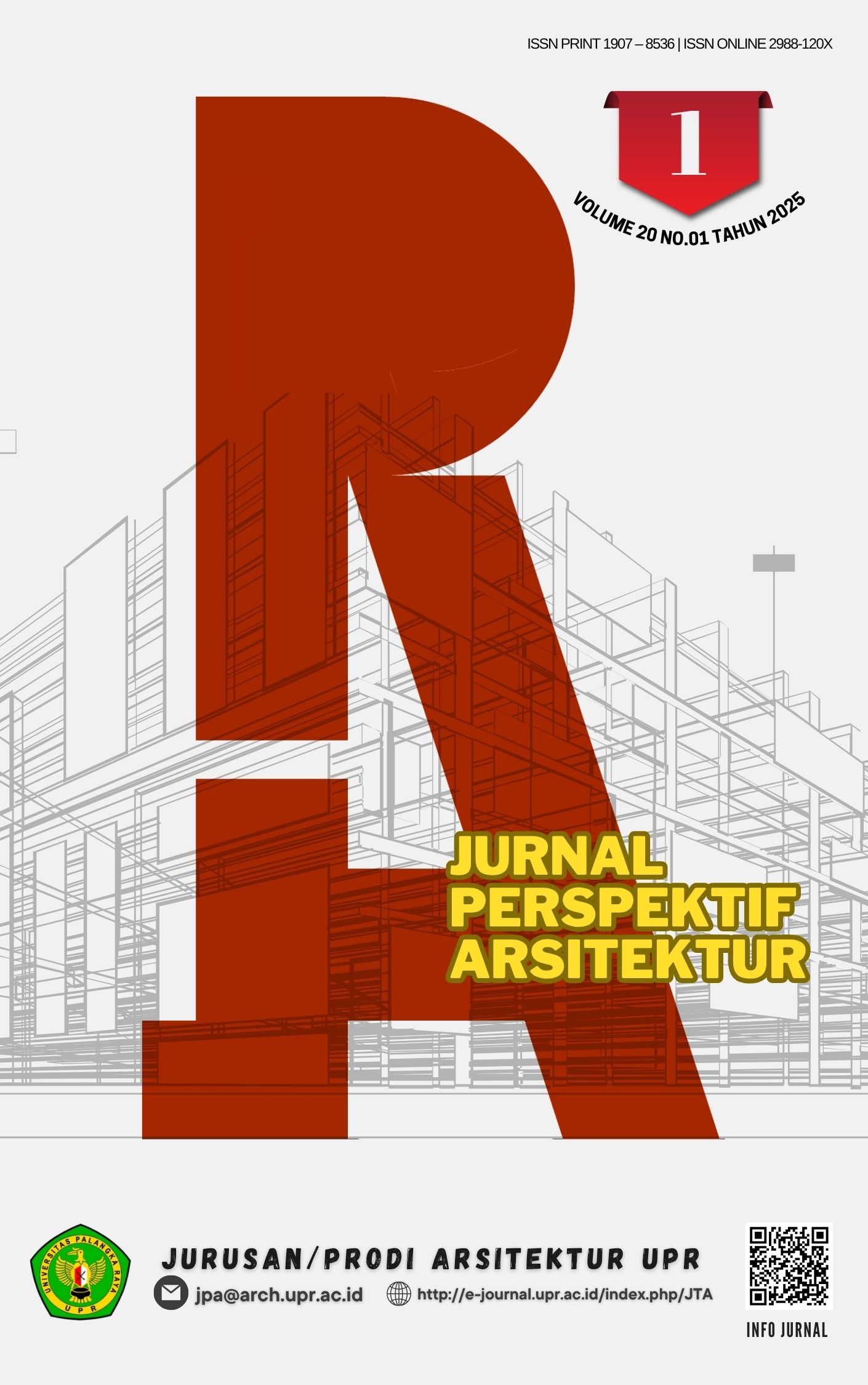PERANCANGAN BUTTERFLY EDUPARK MELALUI METODE BIOMIMIKRI DI PALANGKA RAYA
Indonesia
DOI:
https://doi.org/10.36873/jpa.v20i1.19281Keywords:
Butterfly Edupark, Konservasi Kupu-kupu, Biomimikri, Palangka RayaAbstract
The lack of concern for the ecosystem and limited knowledge about butterflies,
emphasizes the urgency to present a place that can display or demonstrate the life of butterflies as
a means of education, recreation, and conservation in Palangka Raya. As a built open space that
has ecological and social functions, harmony between the two is important to create an optimal
area in terms of butterfly habitat conservation. By imitating the mechanism of life and how
butterflies can adapt to the surrounding environment through the principle of biomimicry
adaptation, it is expected to be able to provide a positive relationship between habitat, humans,
and the surrounding environment. The idea applied comes from the life cycle of butterflies which is
implemented through the form of organisms and the behavior of butterflies. Combining natural
elements and creating an interactive and harmonious experience with the surrounding
environment, Butterfly Edupark is here to increase knowledge, awareness, and pro-conservation
attitudes to the Palangka Raya community through education.
Downloads
References
A. D. Gonggoli, S. Sari, H. Oktofiani, N. Santika, R. Herlina, T. Agatha, dan Y. E. Gunawan, “Identifikasi Jenis Kupu-Kupu (Lepidoptera) Di Universitas Palangka Raya,” Bioeksperimen, vol. 7, no. 1, pp. 16–20, Mar. 2021.
F. Tuju, A. Fatiqin, A. M. Kadafi, Decenly, M. Dirgantara, M. Ulaan, dan Y. Nugroho, “Keanekaragaman Spesies Kupu-kupu (Lepidoptera) pada Habitat Ekowisata Kawasan Hutan Desa Tahawa Kabupaten Pulang Pisau,” J. Biotropica. Res. Nat. Technol., vol. 1, no. 2, 2023.
Y. Indriani, L. N. Ginoga, dan B. Masy’ud, “KEANEKARAGAMAN JENIS KUPU-KUPU DI BEBERAPA TIPE HABITAT DI PONDOK AMBUNG TAMAN NASIONAL TANJUNG PUTING KALIMANTAN TENGAH,” Media Konservasi, vol. 15, no. 1, pp. 1–12, Apr. 2010.
I. W. Natasa, “KEANEKARAGAMAN KUPU-KUPU (Lepidoptera) DI PLAWANGAN KAWASAN TAMAN NASIONAL GUNUNG MERAPI, DAERAH ISTIMEWA YOGYAKARTA,” UNIVERSITAS ATMA JAYA YOGYAKARTA, YOGYAKARTA, 2016.
H. Ruslan, A. Satiyo, dan Yenisbar, “Keanekaragaman kupu-kupu (Lepidoptera: Papilionoidea) di Kawasan Pusat Pendidikan Konservasi Alam Bodogol, Taman Nasional Gunung Gede Pangrango, Jawa Barat,” J Entomol Indones, vol. 20, no. 1, pp. 10–21, Mar. 2023, doi: https://doi.org/10.5994/jei.20.1.10.
M. Wolf dan A. Rinzler, the educational park: A Guide to its Implementation. New York: CENTER FOR URBAN EDUCATION, 1970.
P. Davidoff, Education Parks: Appraisals of plans to improve educational quality and desegregate the school. Washington DC: CLEARINGHOUSE PUBLICATION NO. 9, 1967.
G. Devier, “Environmental Learning Parks,” UW Homepage.
D. Ariani, B. Sulistyantara, dan T. Budiarti, “Formulation of design concept of urban park using butterflies as a good urban environment bio-indicator,” IOP Conf. Ser.: Earth Environ. Sci. 179, 2018, doi: 10.1088/1755-1315/179/1/012024.
M. Pawlyn, BIOMIMICRY in ARCHITECTURE, 2nd ed. Newcastle upon Tyne: RIBA Publishing, 2016.
Aziz dan El sherif, “Biomimicry as an approach for bio-inspired structure with the aid of computation,” Alexandria Engineering Journal, vol. 55, no. 1, pp. 707–714, 2016.
M. P. Zari dan J. Storey, “An ecosystem based biomimetic theory for a regenerative built environment,” in Conference: Lisbon Sustainable Building Conference (SB07), Lisbon, Portugal, 2007.
T. Heath, Method in Architecture, Illustrated. Michigan: Wiley, 2007.

Downloads
Published
How to Cite
Issue
Section
License
Copyright (c) 2025 Jesica Leilani, fredyantoni F. Adji, Onie Dian Sanitha

This work is licensed under a Creative Commons Attribution 4.0 International License.







